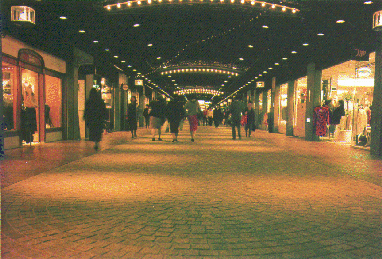SPONSORED
An Underground city is a series of linked subterranean spaces that may provide a defensive refuge, a place for living, working or shopping, a transit system, mausolea, wine or storage cellars, cisterns or drainage channels or several of these. The term may also refer to a network of tunnels that connects buildings beneath street level.These tunnels may house office blocks, shopping malls, metro stations, theatres, and other attractions.[ Source ; Wikipedia ]
These passages can usually be accessed through the public space of any of the buildings connecting to them, and sometimes have separate entries as well. The latter definition encompasses many modern structures, while the former more generally covers tunnel systems from ancient times to the present day. An underground city is a network of tunnels that connects various buildings below the street level. These may include office blocks, metro stations, underground shopping malls.
These passages can usually be accessed through the public space of any of the buildings connecting to them, and sometimes have separate entries as well. The latter definition encompasses many modern structures, while the former more generally covers tunnel systems from ancient times to the present day. An underground city is a network of tunnels that connects various buildings below the street level. These may include office blocks, metro stations, underground shopping malls.
Underground structures or networks are usually found in countries with cold climate. For example, the temperature in Canada in winter is -10 degree Celsius. The climate in Canada does not permit free movement over ground. That is the reason for the development of underground cities. Montreal’s RESO is the world’s largest Underground city in Canada. It is popularly known as “Double Decker City“.
Underground cities usually have entrances through public spaces. The underground structure rises over ground and provides for a proper entrance to the underground structure.
 |
| Tenjin underground City, Japan |
There are some underground tunnels that have an opening on the ground which slowly leads the traffic to the underground city.
Underground cities are similar in nature to skyway systems and may include some buildings linked by skyways or above ground corridors rather than underground. The purpose of construction of skyways or underground cities is the same which is protection from weather.
A skyway, catwalk, sky bridge, or skywalk is a type of pedway consisting of an enclosed or covered bridge between two buildings. This protects pedestrians from the weather. These skyways are usually owned by businesses, and are therefore not public spaces (compare with sidewalk). Skyways usually connect on the first few floors above the ground-level floor, though they are sometimes much higher, as in Petronas Towers, SWFC and Kingdom Centre (though this skyway is often referred to as a sky bridge). The space in the buildings connected by skyways is often devoted to retail business, so areas around the skyway may operate as a shopping mall. Non-commercial areas with closely associated buildings, such as university campuses, can often have skyways and/or tunnels connecting buildings. [ Source ; Wikipedia ]
Skyways are usually seen in business buildings and therefore not common in public spaces. Skyways usually connect the two buildings on the first few floors above ground, they could be higher too. Petronas Towers is an excellent example of a skyway. This skyways being higher is referred to as Sky bridge.
The world’s largest skyway network – Calgary, Alberta’s “+15 Walkway” system – has a total length of 16 km (10 miles). However, the system is discontinuous, and it does not connect every downtown building. The largest continuous network of skyways – the Minneapolis Skyway System – spans 8 miles (13 km) connecting 69 blocks in downtown Minneapolis.)
Montreal’s Reso is the world’s largest underground city network used by millions of people. Toronto’s Path is the world’s underground shopping complex which has 371,600 square metres of retail space.
Japan has individually smaller networks but are the most extensive networks. It has a total of 76 underground shopping streets totalling over 900,000 square metres of floor space in 1996, with many expansions since then.
Many countries round the world have developed the concept of an Underground City. Some of the countries which have underground cities are:
1. Argentina
2. Australia
3. Canada
4. Chile
5. China
6. Finland
7. France
8. Germany
9. Greece
10. Hong Kong
11. India
12. Iran
13. Italy
14. Japan
15. Mexico
16. Pakistan
17. Russia
18. Singapore
19. Spain
20. Switzerland
21. Taiwan
22. Thailand
23. Turkey
24. Ukraine
25. United Kingdom



